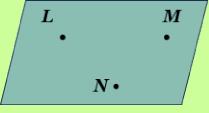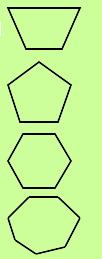|
"Understanding vocabulary is KEY to success on standardized tests," says Mrs. S-S. "It is one of the main reasons students often fail or score poorly!"
Math terms are actually not difficult to learn and since they don't change year-after-year, it is definitely best to get them under your belt. Let's take a look at the basic geometry terms. They're the same ones from elementary school.
|
|
|
|
 |
|
|
point - a point names a location in space and has no size, it is represented by a dot
|
|
|
|
|
 |
|
|
segment - a segment or line segment is part of a line and is designated by two endpoints and is composed of all the points between them
|
|
|
|
|
 |
|
|
ray - a ray is part of a line; it begins at an endpoint and extends indefinitely in the other direction
|
|
|
|
|
 |
|
|
line - a straight, one-dimensional figure that has no thickness and goes on indefinitely in both directions
|
|
|
|
|
 |
|
|
endpoint - a point at one end of a ray or at the beginning and ending of a segment
|
|
|
|
|
 |
|
|
angle - a figure where two rays share a common endpoint (vertex)
|
|
|
|
 |
|
|
plane - a flat, 2-dimensional surface, has no thickness, and goes on forever and ever in all directions…
a plane can be defined by three points
|
|
|
|
|
 |
|
 |
|
|
polygons - 2-dimensional flat shapes made from straight line segments that don't cross over one another
|
|
|
|
 |
|
|
|
|
|
 |
|
 |
circle - a set of points in a plane equidistant from a given point
|
|
 |
|
|
|
 |
|
|
area - the number of unit squares that can be fit into the space outlined by a closed curve
|
|
|
|
The name of a polygon depends upon the number of sides it has:
|
|
|
|
 |
|
|
 |
|
|
triangle: 3 sides
- sum of interior angles: 180º
|
|
|
octagon: 8 sides
- sum of interior angles: 1080º
|
|
|
|
|
|
 |
|
|
quadrilateral: 4 sides
- sum of interior angles: 360º
|
|
|
nonagon: 9 sides
- sum of interior angles: 1260º
|
|
|
|
|
decagon: 10 sides
- sum of interior angles: 1440º
|
|
|
pentagon: 5 sides
- sum of interior angles: 540º
|
|
|
|
|
hexagon: 6 sides
- sum of interior angles: 720º
|
|
|
dodecagon: 12 sides
- sum of interior angles: 1800º
|
|
|
|
|
heptagon: 7 sides
- sum of interior angles: 900º
|
|
|
n-gon: n sides
- sum of interior angles:
|
|
|
|
|
|
|
|





